Using the trademark Allocation agreement, trademark rights can be transferred. The original owner Allocation a trademark to another entity, and ownership passes to the new owner, with or without goodwill, for a limited number of services or goods.
The Allocation of trademarks, which is also known as an assignment agreement, can be signed even if the trademark registration has not been done; innovative creators and inventors, for instance, are often asked to give ownership of their work to the company that appointed them. In addition, already registered trademarks can also be assigned.
In either case, the assignee must apply to the trademark registrar within 6 months. To learn more about what the trademark assignment deed gives, read this article.
What Is a Trademark?
When a company trademarks its products and services, it uses a sign, a name, a logo, or any combination of these. This is to distinguish its products and services from those of its competitors. It may consist of a design, a logo, a phrase, a word, a name, or a signature.
By registering your trademark, you will be able to prevent your trademark from being copied or misused by any other unauthorised individual or any third party without your consent. TRIPS, which stands for Trademark Related Aspects of Intellectual Property Rights, outlines trademark law from Articles 15 to 2. Under the trademark contract, trademarks that are renewed more than one year before the end date will receive seven years of protection.
Let’s Understand About Allocation of Trademarks
It outlines the transfer of a trademark owner’s rights, title, and interest in and to the service mark/trademark. During the assignment process, the assignor transfers property rights in the mark to the assignee. However, It differs from a license. A license is just permission to use a trademark; it is not a transfer of ownership rights and is associated with a TTA or Technology Transfer Agreement. Agreements of this nature are paramount to taking place as an additional Intellectual Property (IP) may result in the company being in a bind. This plays a vital role in its monetization as well.
Different Types of Allocation of Trademarks
- Complete Allocation of trademarks: As part of this type of Allocation, the trademark owner transfers all rights and ownership of their trademark to the other party or assignee. Additional rights may also be transferred to a subsequent assignee. After completing the assignment, the trademark owner completely loses all rights to the trademark, and the assignee or other party or individual holds all the trademark rights and ownership.
- Partial trademark Allocation: As part of this type, trademark ownership is transferred to a limited number of products and services. the assignor holds all rights over the portion not being assigned to the assignee. Assignors have the exclusive right to choose the partial agreement. Assignors may utilize these rights in their management and business operations
- Allocation of a trademark with Goodwill: The assignor can transfer the trademark ownership rights as well as the image-valued rights over the trademark in this case. The assignee can then use such a demonstration in the trademark’s market reputation to promote the product
- Allocation of the trademark without Goodwill: The assignor may restrict the assignee from using the trademark in the assignee’s business. In addition, the assignee may restrict the assignee from using the trademark in its product. The same trademark is used by both the assignee and assignor in different fields of business. A gross trademark Allocation also falls under this category. As per the Trademark Mark Act, there are some limitations on the Allocation of already registered trademarks under Section 40 of the Trade Marks Act, which may cause confusion for the public.
What Are the Advantages of the Allocation of Trademarks?
The following are the primary benefits of a trademark allocation agreement
- Unlock Value: A agreement allows the owner of a brand to unlock the value of the brand, which was previously only valuable on paper. On the other hand, the assignee may be wiser to enter a market with an already well-established brand rather than creating a new one, which takes more time and money
- Valid Proof: The agreement can be used to establish the legal right to the trademark if there is a problem. It is the responsibility of the trademark registrar to ensure that all the checks are in place by verifying the validity of all the clauses in the trademark contract. This is done by publishing them in the trademarks journal.
Registration of an Allocation of Trademarks
Under Section 45 of the Trade Mark Act, 1999, the Trade Mark Allocation is registered. If an individual becomes permitted by assignment to use a registered trademark, they should apply to the trademark registrar to have their title registered. The trademark registrar shall register the applicant as the trademark owner for the products and services in relation to trademark Allocation upon receipt of the application.
If there is any judicial doubt about the statement’s reliability or any document provided, the trademark registrar may require additional evidence and statements as proof of name/title.
If the validity is in dispute between the parties, the trademark registrar may reject the assignment registration until the parties’ right has been determined by a knowledgeable court. Unless an application is filed in the manner mentioned above, the Allocation of the trademark will fail if someone acquires a conflicting interest in or under the registered trademark without comprehending the trademark assignment.
Transmission Agreement
In general, trademarks are assigned by way of a properly drafted and executed Allocation of trademarks, which specifies the transfer of a trademark from one entity to another, which is the owner of another entity.
When drafting such an agreement, it is important to ensure that
- Despite being subject to obligations, the trademark owner’s rights are not adversely affected
- The choice regarding whether it should include or exclude the business’s goodwill has been negotiated
- You draft the agreement with the desired outcome in mind.
License agreements are used to license trademarks. Trademark Act, 1999, contrary to the requirement in a case of an agreement, registration of a mark with the trademark registrar is optional, advisable, and not mandatory. Lastly, as in a trademark contract, the licensee’s responsibilities and rights must be clearly outlined and predetermined while drafting the license agreement. It is vital to safeguard the licensor’s right in its own brand, prevent any misuse, and prevent the Licensee’s unauthorized use of the brand.
Conclusion
Allocation agreements of trademarks are one of the most important factors in intellectual property. It allows the owner to transfer ownership rights for commercial purposes and ensure that financial gains are transferred to them. In a written contract, there is a transfer of rights between two parties that is legally enforceable. The document outlines and protects the exclusive rights of all parties or entities involved in the agreement. As part of this agreement, the assignee is also granted full ownership of the assignor’s trademarks.
Also, Read:










